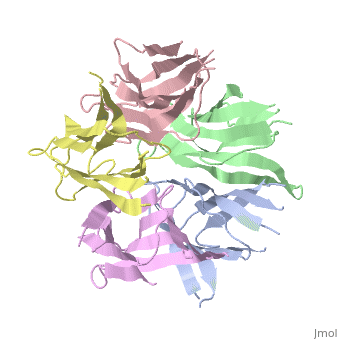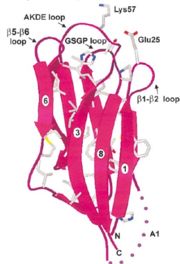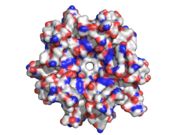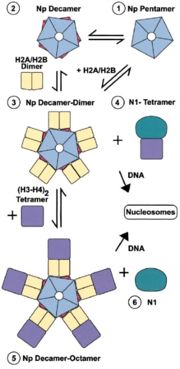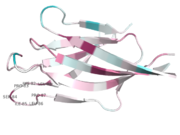Nucleoplasmin
From Proteopedia
FunctionNucleoplasmin (Npl) is a molecular chaperone. Npl functions in the proper assembly of nucleosomes and chromatin structures[1]. He is participates in histone storage, sperm chromatin decondensation, and nucleosome assembly,enome stability, ribosome biogenesis, DNA duplication and transcriptional regulation. In the assembly of nucleosomal arrays the NP transfer to DNA to him by binding the histones, this reaction requires ATP. RelevanceApoptotic chromatin condensation, one of the hallmarks of apoptosis, is regulated by Npl. Structural highlightsNucleoplasmin (NP) is made out of five ,that create ring-shaped histone chaperone. The monomers are formed by a that responsible for oligomerization, that make the protein highly stable and compact. The NP core is made out of eight β strands that form a barrel with a jellyroll topology. Residues in the hydrophobic core are highly conserved (aproximate 80%). The AKDE and GSGP motifs are ordered loops and may function in decamer formation. The activation of NP is by strong destabilization of the pentamer, probably due to electrostatic repulsion. The NP needs compact and stable structure so he can accumulate negative charges that weakens its quaternary interactions, and its required for its biological function. Those segments contained poly-glu and a nuclear localization signal (NLS), and it is thought to adopt a natively disordered conformation.
Decamer coreThe stability is provided by interactions between Asp58 and Lys82 which are mediated by waters. In addition a salt bridge between Lys57, Glu59, and a bound water helps to neutralize destabilizing interactions between Lys57 residues in opposing pentamers. negative charges are present near the pentamer-pentamer interface and affect the connection between the two pentamers.
Activation by PhosphorylationNP decondensate the chromatin by the poly-glu tail, Phosphorylation on the core domain is also required for efficient decondensation. Partial phosphorylation can give the protein the ability to bind core histones, but only hyperphosphorylation of specific regions of both protein domains can make the decondensation process to begin. The hyperphosphorylation is correlated with an enhanced H2A/H2B dimer exchange activity during the decondensation of sperm chromatin. orthologey in Homo sapiensthe NP in Humans is made out of while each consisted of five chains. The structure remain similiar to the one in Xenopus but with a change in amino acids in its , Val insted of Ile. The Decamer bind H2A-H2B dimers and H3-H4 tetramers simultaneously, In the absence of histone tetramers the pentamer binds H2A-H2B and formes central hub. When H3-H4 tetramers are recruited this results in a functional dimerization of the complex, and the decamer being formed. The interaction between NP and H2A-H2B has a strong electrostatic component and the complex formation results in charge neutralization, which in turn stabilize it by diminishing the repulsion due to the proposed accumulation of negatively charged residues at the face of the NP pentamer.
conservationThe loop in the core domain of Xenopus NP is not highly conserved, while the core domain in human is more conserved compared to Xenopus.The general structure remain similiar, even with changes in amino acids in the core domains between the two species. That can point to the fact they have similar roles as a molecular chaperone in Human and Xenopus.
3D structures of nucleoplasmin1k5j – XlNpl core – Xenopus laevis 2vtx - XlNpl core (mutant) 3t30 – Npl oligomerisation domain - human 1ee5, 1ejy –XlNpl nuclear localization peptide + karyopherin-a 3t30 - Human nucleoplasmin References
2. Taneva SG1, Muñoz IG, Franco G, Falces J, Arregi I, Muga A, Montoya G, Urbaneja MA, Bañuelos S. Activation of nucleoplasmin, an oligomeric histone chaperone, challenges its stability.Biochemistry. 2008 Dec 30;47(52):13897-906. PMID:19055325 DOI:10.1021/bi800975r 3. Dutta S1, Akey IV, Dingwall C, Hartman KL, Laue T, Nolte RT, Head JF, Akey CW. The crystal structure of nucleoplasmin-core: implications for histone binding and nucleosome assembly. Mol Cell.2001 Oct;8(4):841-53. PMID:11684019 4. SHU Te-Jun, ZHANG Yao-Zhou. Nucleoplasmin, an Important Nuclear Chaperone. Chinese Journal of Biochemistry and Molecular Biol. 15 March 2007 http://cjbmb.bjmu.edu.cn/EN/Y2007/V23/I09/718 5. Platonova, O., Akey, I.V., Head, J.F., Akey, C.W.Crystal structure and function of human nucleoplasmin (npm2): a histone chaperone in oocytes and embryos.Biochemistry.2011 Sep 20;50(37):8078-89. PMCID:PMC3172369 DOI:10.1021/bi2006652 6. Sonia Ban˜ uelos,Miren J. Omaetxebarria, Isbaal Ramos,Martin R. Larsen, Igor Arregi, Ole N. Jensen, Jesus M. Arizmendi, Adelina Prado, and Arturo Muga. Phosphorylation of Both Nucleoplasmin Domains Is Required for Activation of Its Chromatin Decondensation Activity. THE JOURNAL OF BIOLOGICAL CHEMISTRY VOL. 282, NO. 29, pp. 21213–21221, July 20, 2007 7. Shuchismita Dutta, Ildiko´ V. Akey,Colin Dingwall, Kari L. Hartman,Tom Laue, Robert T. Nolte,James F. Head, and Christopher W. Akey. The Crystal Structure of Nucleoplasmin-Core: Implications for Histone Binding and Nucleosome Assembly. Molecular Cell, Vol. 8, 841–853, October, 2001 8. Isbaal Ramos, Jaime Martín-Benito, Ron Finn, Laura Bretan˜, Kerman Aloria, Jesu´ s M. Arizmendi, Juan Ausio´, Arturo Muga, Jose´ M. Valpuesta, and Adelina Prado. Nucleoplasmin Binds Histone H2A-H2B Dimers through Its Distal Face. THE JOURNAL OF BIOLOGICAL CHEMISTRY VOL. 285, NO. 44, pp. 33771–33778, October 29, 2010 | ||||||||||||
